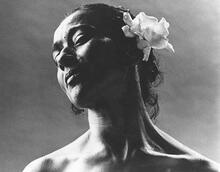Katya Delakova
Katya Delakova trained in ballet and interpretive dance and performed with the renowned Gertrud Kraus. In 1931 she married stage director Ferdo Delak and opened a dance school in Yugoslavia. She divorced Delak in 1938 and immigrated to the United States, where she married fellow dancer Fred Berk in 1946. The couple performed Jewish, folk, and modern dances together. In 1943 they formed the Jewish Dance Guild, teaching at the Jewish Theological Seminary, and in 1948 they toured the displaced persons camps of Europe and the newly formed State of Israel. In 1951, she moved to Israel, where she studied Eastern movement principles. She returned to the US in 1958 to teach “the Art of Moving.” From 1966–1975 she taught this method at Sarah Lawrence College, as well as at her own studio. In 1977 she moved to Titusville, New Jersey, where she continued to teach students at her private studio.
Dancer and choreographer Katya Delakova was a pioneer in incorporating Jewish experience into dance. Delakova applied themes from the Bible, Hasidic elements of worship, and American and European folk dance in the creation of theatrical dances for the stage. She later explored Old Testament themes using improvisation, developing a highly effective method for making large-scale dance-theater works. Her innovative teaching method, which drew from Eastern traditions like tai chi chuan along with modern and folk dance, was particularly influential in America and Germany.
Early Life
She was born Katya Pollack on September 8, 1914, in Vienna. Her mother, Recha, was a homemaker. Her father, Siegfried, was a newspaper editor. Her early training was in ballet and interpretive dance, and she later received a diploma from the Academy of Music and Dance. In Vienna, she studied and performed with the celebrated modern dancer Gertrud Kraus, who encouraged students in intense self-expression through movement. In 1931, she met and married stage director Ferdo Delak, and moved to Yugoslavia, where she performed and ran a school. In 1938, she divorced Delak, and returned to Vienna because she feared for her family under the reign of the Nazis. In 1939, fleeing from persecution, she immigrated to the United States, where she performed briefly with a friend, Nina Dova, as the “Delova Sisters.”
Jewish Dance in New York
During the 1940s, Delakova’s career was closely aligned with that of a fellow dancer from Vienna, Fred Berk, whom she married on October 1, 1946. Berk (born Fritz Berger) had also danced with Kraus and escaped the Nazis, arriving in the United States in 1941. In New York, the two began to dance as a team at nightclubs and the Yiddish theater. Together they built a repertory of Jewish, modern, and folk dances which they performed at a variety of locations, including the Times Hall Theater, Carnegie Hall, the 92nd Street YM-YWHA, and the American Museum of Natural History. They also performed for Jewish youth groups, the Manhattan Zionist Club, and the Society for the Advancement of Judaism. Their passion for Jewish dance led to the formation of the Jewish Dance Guild (c. 1943) under the auspices of the Jewish Theological Seminary, where the couple also taught and performed. Through the 1940s, Delakova and Berk danced for the Hebrew Arts Council and the Lecture Bureau of the Jewish Welfare Board (formed to supply artists, lecturers, and cultural programs to Jewish community centers throughout the country). During this time, they also worked with celebrated modern dancers Hanya Holm and Louis Horst. In 1948, the couple toured the displaced persons camps in Europe and, in 1949, the newly established State of Israel.
Dance in Israel
Following her separation from Berk in 1951, Delakova spent five years in Israel (1953–1958), where she expanded her focus to include Eastern movement principles through extensive studies with Dr. Moshe Feldenkreis. She also ran a school and performing group, and mounted celebrations for A voluntary collective community, mainly agricultural, in which there is no private wealth and which is responsible for all the needs of its members and their families.kibbutzim. In 1958, Delakova returned to New York with her new husband (married January 14, 1953), the musician, composer, and conductor Moshe M. Budmor, with whom she frequently collaborated.
The Art of Moving
From the 1960s on, Delakova developed what she termed “the Art of Moving,” an innovative system of teaching movement that encompassed disciplines of body training from both Eastern and Western sources, with a strong emphasis on improvisation using Jewish themes. This was the focus of her work at both Sarah Lawrence College (where she taught c. 1966–1975) and her private studio, the Katya Delakova School, in New York City. From 1973 onward, Delakova and Budmor spent up to three months of each year teaching in Switzerland, Denmark, Israel, and Germany. In 1977, the couple moved to Titusville, New Jersey, where Delakova continued to run a private studio and work with talented students from her trips abroad.
Delakova died of cancer on April 10, 1991, at age seventy-six.
Selected Works by Katya Delakova
Beweglichkeit: Wie wir durch Arbeit mit Korper und Stimme zu kreativer Gestaltung finden (1984).
Dances of Palestine, with Fred Berk (1947).
Das Geheimnis der Katze: eine Tanzerin und Lehrerin weist Wege zum schopferischen Uben (1991).
Gliederspiele (n.d.).
Jewish Folk Dance Book, with Fred Berk (1948).
Wo Befinde Ich Mich (1979).
Ingber, Judith Brin. Victory Dances: The Life of Fred Berk, a Modern Day Jewish Dancing Master (1985).
Mayer-Ostrow, Jacqueline. “Hommage an Katya Delakova Budmor.” Tanz actuell Jahrg. 6, no. 6 (December 1991/January 1992): 55.




